
InforShell

|
InforShell |
|
PSS |
As is known, power system distribution networks are complex systems and could involve large amount of data and as well data categories, for example, distribution network one-line diagrams, geographic location, network device parameters, network topology and network status data. To facilitate data management work in power supply and distribution organizations, PSS provides a set of tool kits that can
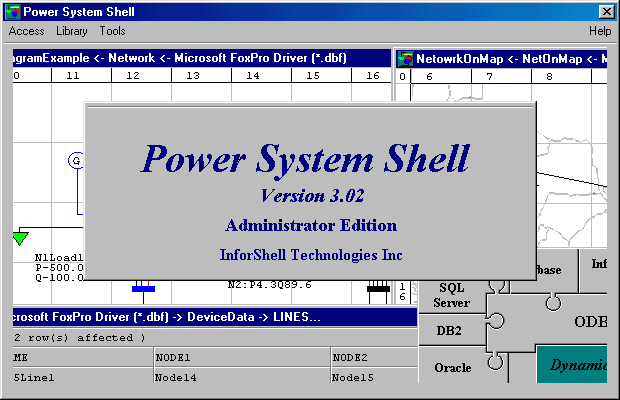 |
PSS can help
|
|
|
For power system engineers and administrators PSS can be used as a desk top information management system. Using PSS power system engineers and administrators can create classified libraries relating individual work. The following information categories can be managed via the libraries: |
| One-line diagram | Network topology | Network location |
| Operation data | Load data | Subsystem data |
| Reliability data | System description | Financial data |
| Design data | External factors | Company policies |
|
For power system application program developers PSS can be used as an user interface for windows. PSS provides calculation program developers with a complete database operation environment and facilities for drawing large scale one-line diagrams, describing distribution network topologies, registering calculation programs and exchanging data with registered programs. Using PSS, developers can save a considerable effort of implementing user interface for individual application programs such as simulation, monitoring, data analysis and calculation programs.
|
|
For researchers Researchers can use PSS to build individual power distribution network models and manage relevant data, especially in meeting specific requirements for their research work such as specific data formats and parameter extensions. PSS can also support data exchanging with customized application programs or commercial software such as MS-Excel for required analysis and calculation work.
|
To facilitate managing distribution network data, PSS supports you to establish and use a set of information libraries. Each library is composed of a group of automatically generated database data tables. The PSS libraries and facilities can be categorized into two tool kits:
|
|
PSS supports users to build symbol libraries to store customized power distribution network device symbols that can be used for drawing distribution network one-line diagrams. Users can draw and define device symbols in accordance with the relevant standards that apply in their companies or counties. If a symbol library is built on the server of a computer network then the symbols in the library can be shared by multi-users of the network.
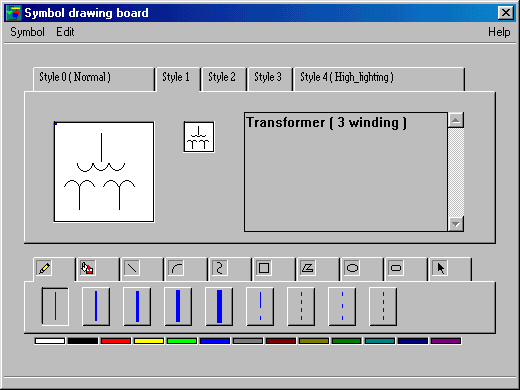 |
|
A geographical map library is for constructing and storing maps of the areas that are covered by the power distribution network being considered. The maps in the library can be used as the background when drawing distribution network one-line diagrams. A geographical map library provides a five-layer drawing board for users to construct maps. The proportion from a layer to its next lower layer is 1:10. The size of each layer is free from the restriction of computer internal memories. Users can Zoom In/Out among these layers and move them up, down, left and right continuously. The maps in a geographical map library can be shared by multi-users of a computer network.
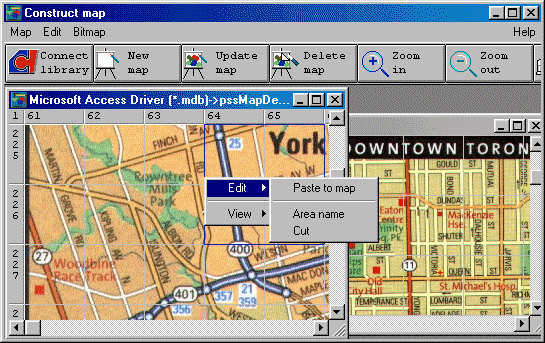 |
|
A diagram library is for drawing and storing power distribution network one-line diagrams. The symbols in a symbol library can be used in drawing one-line diagrams. Users can draw either standard network one-line diagrams or geographical map based diagrams. Similar to a geographical map library, a diagram library also provides a five-layer drawing board for users to draw diagrams. The proportion from a layer to its next low layer is 1:10. The size of each layer is free from the restriction of computer internal memories. Users can Zoom In/Out among these layers and move them up, down, left and right continuously. A diagram library can be shared by multi-users if on a computer network.
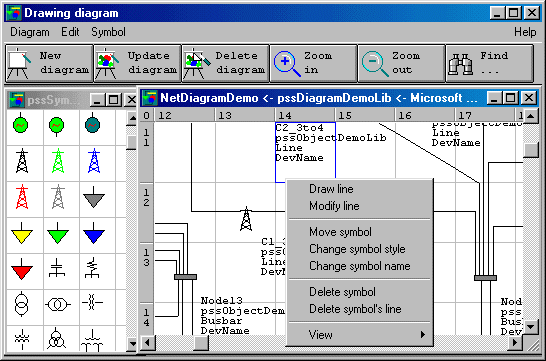 |
|
Usually individual electrical power supply companies in different countries or areas will record power system data in the format defined by themselves. Also power system off-line engineers will use only the data formats that are specifically required for individual tasks. Therefore PSS allow you to define the structure of the database tables according to the data formats you require. PSS provides database table creating and modifying facilities for users to construct device data libraries. A device data library could contains a number of database tables for recording power distribution network device data and network operational data. When creating a device data library users can require it to be compatible with any of the database systems supported by ODBC such as Oracle, Sybase, SQL Server, dBase, FoxPro and Paradox. A device data library can be shared by multi-users if on a computer network.
|
|
To facilitate the users who are not familiar with SQL to access relative databases, PSS provides a Database Access Interface that is composed of a series of dialog boxes. Users can simply choose items from the given menus to obtain the automatically constructed corresponding SQL statements to access, modify, insert and delete the data in the target database. Via the Database Access Interface, users can access most of commercial databases such as Oracle, Sybase and SQL Server. Other facilities of the Database Access Interface include spreadsheet, bar chart, curve and statistical calculation.
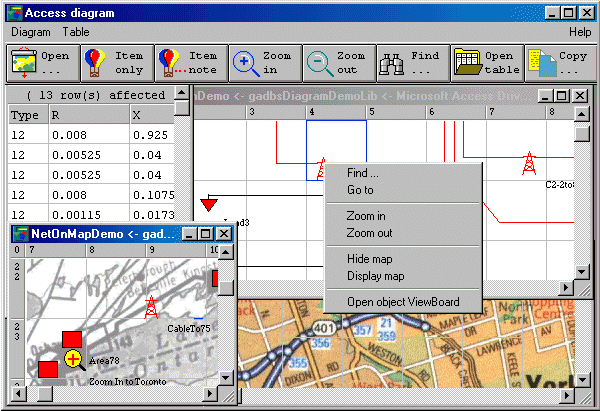 |
|
To facilitate reviewing network running status data for relevant statistic analysis and monitoring tasks, PSS provides users with a data collecting tool to cyclically record the data collected via on-line data acquisition systems into PSS database.
|
|
As varied ASCII file formats are being used in different power system application programs, you may need to organize relevant data in the different ASCII file formats required for using individual application programs. PSS can make this much easier for you. PSS provides users with a set of Data Exchange Interface constructed using ODBC and SQL. Via this interface set, users can easily access different databases to get required data and generate input ASCII files for application programs.
|
|
PSS can be used as a graphical user interface for power system application programs such as simulation, monitoring, data analysis and calculation programs. PSS provides users with an application management tool to manage and execute application programs.
|
|
To protect databases from an illegal access in a computer network, PSS supports setting user ID and password. To ensure data recoverability PSS program is separated from database systems. In case an interruption occurs in the program execution the related database systems will not be damaged and users can restart or re-install the PSS program to continue accessing the data in the databases.
|
| PSS supports users to construct distributed information management systems (Client/ Server) in order to share information collected and stored in the host computer (Server). |